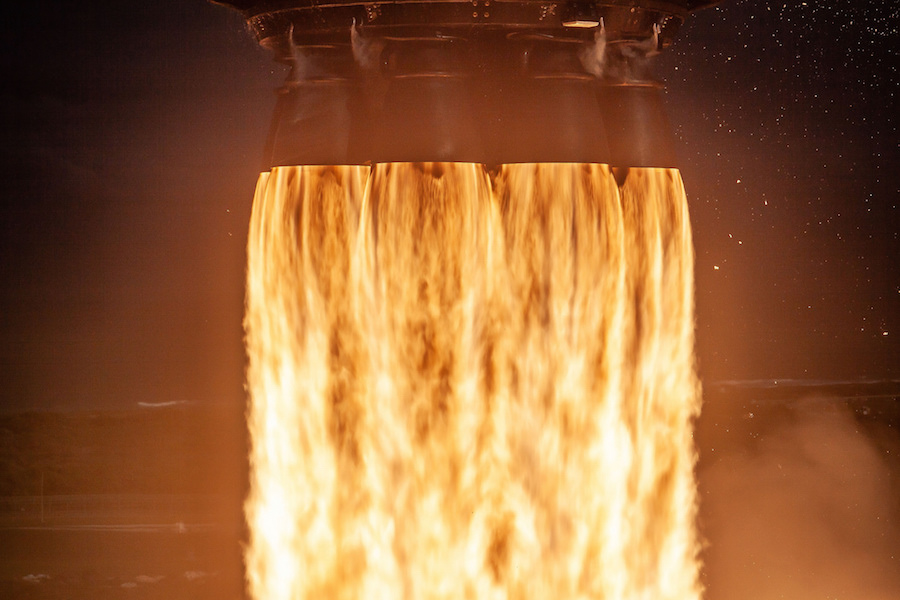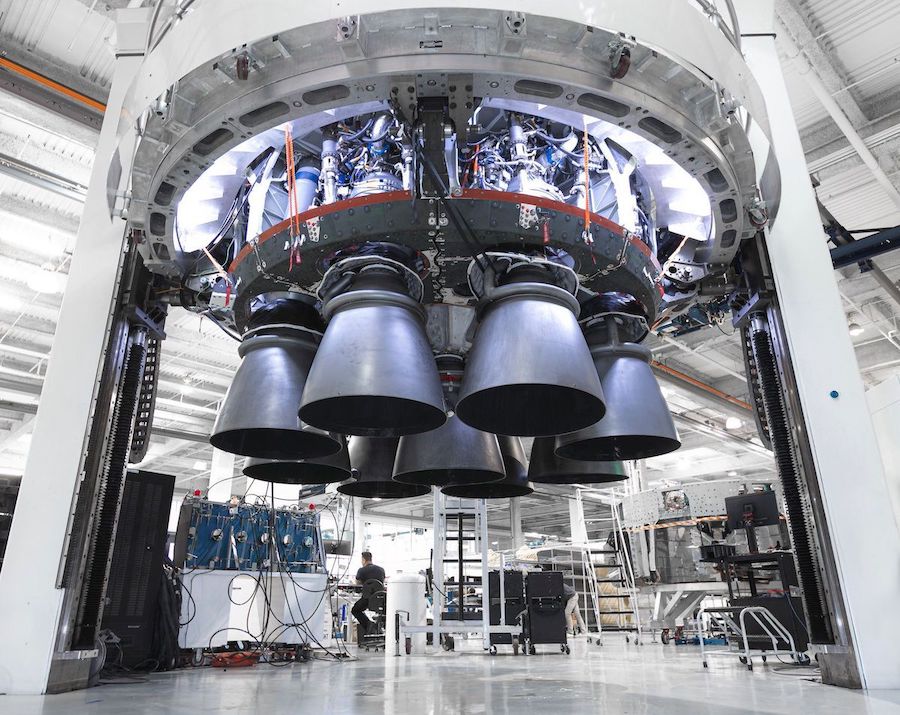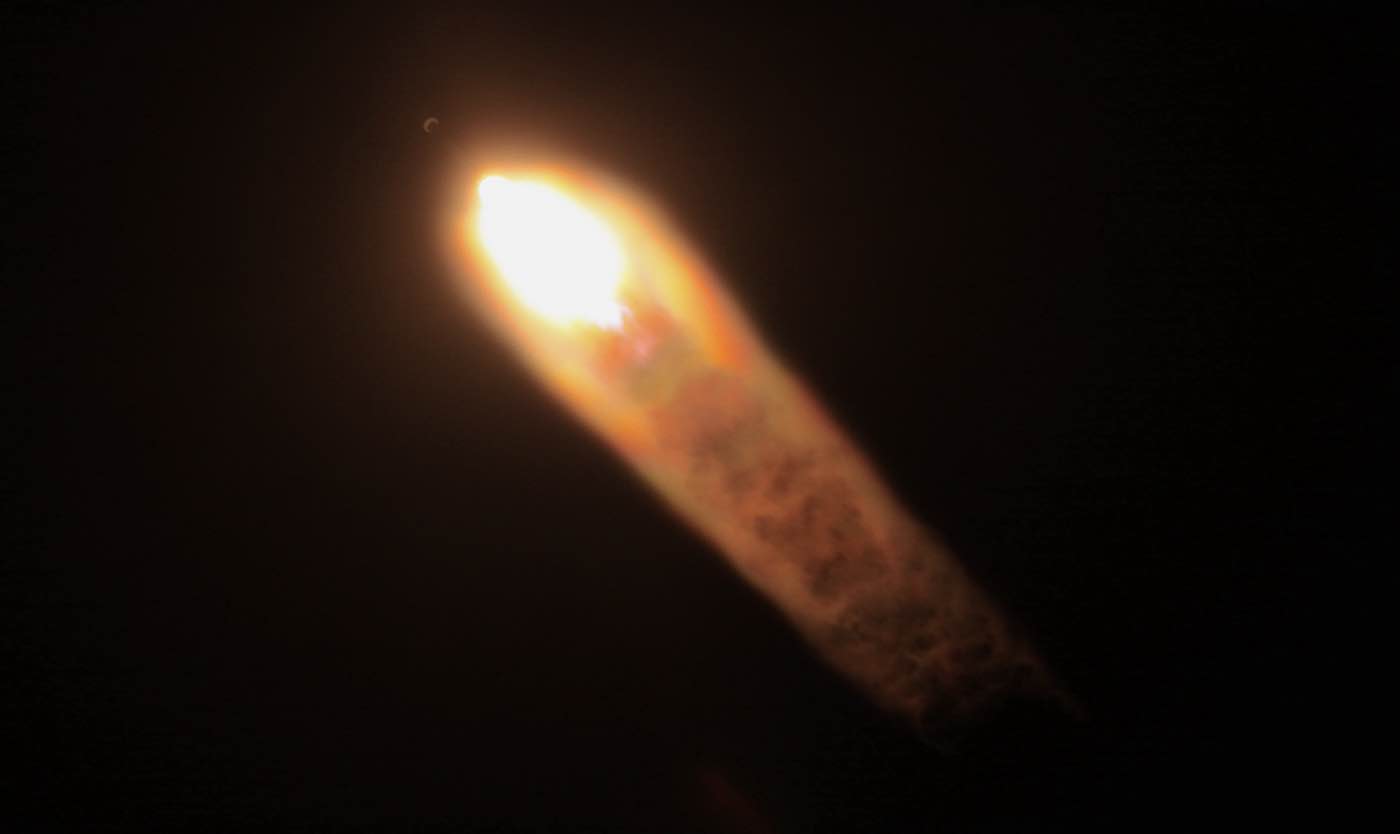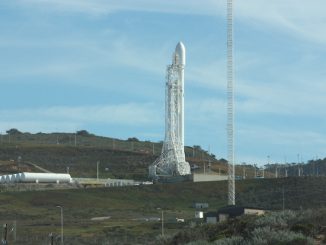
SpaceX has concluded fatigue on an engine cover caused one of the nine Merlin 1D first stage engines on the company’s most recent launch to shut down early during ascent, leading to the loss of the booster during an offshore landing attempt in the Atlantic Ocean, an official said Monday.
A hole developed in one of the covers on the Feb. 15 launch, allowing hot gas into one of the engines, according to Benji Reed, senior director of human spaceflight programs at SpaceX. Reed disclosed the findings in a press conference Monday previewing SpaceX’s next crew launch for NASA, currently scheduled to fly to the International Space Station in late April.
The early engine shutdown did not affect the Falcon 9 rocket’s primary mission, and the launcher’s upper stage continued into orbit and successfully deployed 60 Starlink internet satellites about an hour after the Feb. 15 liftoff from Cape Canaveral Space Force Station. But the problem prevented the rocket from landing on SpaceX’s floating drone ship positioned around 400 miles (630 kilometers) northeast of Florida’s Space Coast.
Reed said the Merlin engines fly with covers, or boots, to protect certain components during flight. One of the boots on the Feb. 15 launch, which flew with a reusable first stage making its sixth trip to space, had more flights than any other boots of the same design, Reed said.
“This particular boot, had a little bit of a hole,” Reed said. “It developed a hole. There are hot gases. Of course, that’s what makes the rocket go up, very hot gases coming out of the engine. But you want those hot gases to be where they’re supposed to be and not go where they’re not supposed to be. So that boot, a little bit of a hole developed, a little bit of hot gas got to where it’s not supposed to be, and it caused that engine to shut down.”
The Falcon 9 rocket has nine Merlin 1D engines, each consuming a mix of super-chilled, densified kerosene and liquid oxygen propellants. The nine Merlin 1D engines collectively generate about 1.7 million pounds of thrust at full power. A single modified Merlin engine flies on each Falcon 9 upper stage.
With a cluster of first stage engines, the Falcon 9 is designed to overcome an in-flight engine failure and still deliver its payload into orbit.
“That’s the great thing about Falcon 9,” Reed said. “We have engine-out capability, plus this vehicle has all of these great systems to autonomously control itself, shut down, abort when it needs to. In this case, it did exactly what it was supposed to do, it cut out that engine, turned that engine off. The vehicle was safe. The vehicle got to orbit, put the satellites exactly where they wanted to be, the primary mission was accomplished.
“When that booster came to return home, because of the problem with that particular engine, we didn’t have enough thrust in order to get back to where we needed to be,” Reed said.
SpaceX did not disclose the ascent engine shutdown until Monday. The engine problem on the Feb. 15 launch was the third time a Merlin booster engine has shut down early on a Falcon 9 launch.
A Merlin engine on an earlier Falcon 9 variant failed in flight in 2012, but the rocket continued into orbit and deployed a Dragon cargo ship on a mission to the International Space Station. But the upper stage’s firing to overcome the first stage engine failure left insufficient fuel on-board to maneuver into a separate orbit and release an Orbcomm communications satellite.
A Falcon 9 launch in March 2020 also suffered an in-flight engine failure, producing a similar outcome to the Feb. 15 mission. The Falcon 9 continued into orbit and deployed its 60 Starlink payloads, and the booster was unable to land successfully.
SpaceX has launched 111 Falcon 9 and Falcon Heavy rocket missions to date. All but one Falcon 9 flight had 10 Merlin engines (a special Falcon 9 configuration for a Dragon abort test did not have an upper stage engine), and the Falcon Heavy missions each had 28 engines, adding up to 1,163 Merlin engine flights in the Falcon 9 era, more than any other large U.S. rocket engine. Accounting for the three in-flight engine failures, the Merlin engine has amassed a 99.7% success record.

Reed said SpaceX is learning about life limits on Falcon 9 booster components as the company sets new records for first stage reuse on Starlink missions. SpaceX’s life-leading booster has launched and landed eight times, and the company is expected to match that record with another Falcon 9 first stage on a Starlink launch this week.
“We get to fly our higher count flight-proven vehicles to take the Starlink satellites to orbit,” Reed said. “The anomaly we saw on this one particularly, it was a higher count vehicle, and some of the components were actually the highest count. They were life-leaders.”
SpaceX engineers can take lessons learned from Starlink launches and determine where to add more inspections during rocket refurbishment, and what components need to be replaced between Falcon 9 flights.
“Here’s where we need more inspections, here are the kinds of components we need to replace, and here’s where we can actually upgrade the system, the algorithms, on the vehicle to even further detect and control what the vehicle needs to do, and that’s what we’re doing as we move forward,” he said.
Hans Koenigsmann, a senior advisor and former vice president at SpaceX, said last week that he expects the company to continue flying Falcon 9 boosters for more than 10 flights, which was once SpaceX’s limit on Falcon 9 reuse before rockets needed a major overhaul.
“I’m pretty sure we will get to 10 flights soon, and then we will continue to look at the booster and make an assessment (whether) we can move forward with it,” he said Feb. 23. “My personal opinion is that we will probably continue until we see more damage on the booster.”
Koenigsmann said SpaceX will look at data rather than specifying a certain number of flights for each booster.
“We will inspect them regularly, at regular intervals” he said. “And the next time you check that the engine held up and see if there’s any damage there. To me, it is an engineering problem. I don’t think the number of 10 is a magic number.
“Also, for example, we could start phasing in new components at some point in time and actually extend the life of the booster,” Koenigsmann said.

Steve Stich, NASA’s commercial crew program manager, said Monday that the space agency is participating in SpaceX’s investigation into the Feb. 15 engine failure.
“We will follow on with SpaceX’s investigation, and we’ll look at that, and that will be something we’ll bring to our program control board and make sure that we have separation from that, and understand that anomaly before we go fly (with astronauts),” he said.
SpaceX plans to launch a reused Crew Dragon capsule on a previously-flown Falcon 9 booster on the company’s next launch of astronauts. NASA commander Shane Kimbrough, pilot Megan McArthur, Japanese astronaut Akihiko Hoshide, and European mission specialist Thomas Pesquet will ride the Crew Dragon “Endeavour” spaceship to the International Space Station in late April. It’s the same capsule that flew with NASA astronauts Doug Hurley and Bob Behnken on a test flight to the space station last year.
Kimbrough and his crewmates will launch on a Falcon 9 booster making its second flight after taking off and landing in November on the previous Crew Dragon mission. The upcoming mission, known as Crew-2, will be the first to fly on a previously-flown Falcon 9 first stage.
“Our team really follows all the Falcon 9 flights, and we learn from each one,” Stich said. “One of the things I really like about what’s happening, is SpaceX’s Starlink flights are pretty far out there in terms of the number of times they’ve flown a booster. We’re about to embark on our first reuse here for a crew vehicle. So what we’re doing is we’re learning from each of those flights, and we’re feeding that back into our certification for reuse.”
Kimbrough said his crew has been briefed every month on the status of the Crew Dragon and Falcon 9.
“We’re very confident that they’re gonna figure out whatever’s gone wrong,” he said. “It’s just been a few little things on a few of these rockets. They’re launching almost once a week, so when you’re launching that often everything is not going to go perfectly. There’s nothing major or catastrophic that’s happened. It’s just a few things on the rocket that are going to get worked out before our flight.”
Email the author.
Follow Stephen Clark on Twitter: @StephenClark1.



